The Origin and Development of Eurythmy 1912–1918
GA 277a
30 August 1915, Dornach
Translated by Steiner Online Library
The Apollonian Course XIII
The topic of this lesson was the representation on stages for the main character and “subordinate character(s)” or choir or choirs. As an example of such a presentation, Rudolf Steiner chose the beginning of the seventh scene from his first mystery drama, The Portal of Initiation, also known as the “Devachan scene,” with Mary and the three soul forces Philia, Astrid, and Luna. The scene was created as an example but was not performed at that time. For the sake of clarity, Rudolf Steiner's general remarks on this type of presentation are placed at the beginning here, although some of them come from the lesson given the next day (August 31, 1915). There, the topic was continued and expanded upon from a new perspective—namely, the presentation on steps in terms of superordinate and subordinate thoughts. References were also given as to which texts could be presented in this way. Originally, therefore, a concrete example was given first – the seventh scene from the first Mystery Drama – before Rudolf Steiner moved on to the general.
Following the explanations on the “Devachan scene,” a somewhat earlier elaboration by Tatiana Kisseleff is documented. In the later elaboration of 1923, the Mercury prelude was performed to music by Leopold var der Pals.
Representation on three levels – using the example of the seventh picture from the “Gate of Initiation”
The dancing of poems and dramas can now take place in various ways. Often, one main character and three subordinate characters appear, or one main character and three choir leaders. One or more choirs can always be added. For example, scenes such as [the seventh picture of] “The Portal of Initiation” can be presented in the following way:
Maria appears as the main character, alongside Philia, Astrid, and Luna. Three stages:
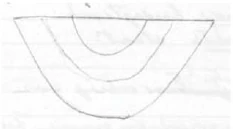
This scene begins with Mercury [the Mercury seal] (somewhat simplified in the dance).
Maria above, the three soul forces arranged in stages (Philia — upper stage, Astrid — middle stage, Luna — lower stage)
Maria
Eurythmically harmoniously developed Maria, who speaks her words herself at the top of the first circle.
Mary does the concrete and abstract and time words (forward and backward) and the vowels i, u (as in as) and a. She expresses spiritually: call, longing, communication, knowledge
in — call, u longing, a communication or knowledge.
But no more vowels than indicated, three movements. The u can also be made as a touch by Maria, as in aum.
When I tried to work out Maria with the doctor, we made very few forms, e.g., the first two lines a concrete angle, the third an abstract form. [...] I only remember that [Rudolf Steiner] said about the gestures i a u for the main character: “It is possible to perform actions within these sounds, e.g., Elektra's sacrificial acts.” The doctor wanted to try this scene with me. But unfortunately, there was not enough time at the time.
Dr. on the board: i — call; u — longing; a — communication or insight.
Philia
Try to bring the whole thing into a response, into a response movement. Fulfillment toward Maria. Vocal movements, keep them as high as possible, and add a choir to do the consonants. // Response – fulfillment, towards Maria (behind), she [Philia] forms all the vowels, the choir adds the consonants (upwards) // A kind of response, the three are the choir, the fulfillment goes towards Maria. Philia vocal movements
Astrid
Again, fulfillment movements, but a little further down with [the] arms like Philia. Astrid vocal-consonantal, the choir is left with [what she doesn't do. // Response - fulfillment. Movement towards Maria, in the middle, she [Astrid] forms the vowels and can choose the consonants, the choir forms the remaining consonants. // Fulfillment movements, interweaving, vocal with consonant. Discuss with the choir which consonants she leaves to them.
Luna
Fulfillment at the very bottom, consonant. Leave the vowels to the choir. // Completely consonant. Leaves vowels to choir. // Response — fulfillment. Movement toward Maria, downward, she forms the consonants, the choir adds the vowels.
The movements of the three soul members only in two dimensions. Think of the body as divided into three planes.
This is how the figures stand before you in the spiritual-real. // This is how you create from the spiritual-real.
Mary expresses fulfillment towards the three.
Mary to Philia follows: "a-movement + call (high)
Maria to Astrid: a-movement, call more downward, a little deeper down
Maria to Luna: a-movement even more downward, all the way down.
In what follows, Maria makes the movement of fulfillment toward the three. “The call of the severely tested penetrates,” to be treated as insight.
Philia: Head posture: Feeling
Astrid: Head posture: Thinking. All movements in the middle plane.
Luna: Head posture: Will
Philia: She moves in Apollonian forms. Head back up. Astrid: Head bowed. Forms Luna: Forms. Head straight ahead
I personally always try to make it clear that Philia, Astrid, and Luna are not identical with the originally given head postures for thinking, feeling, and willing. Dr. Steiner never spoke of zones in connection with thinking, feeling, and willing, but rather for the objective spiritual beings that mediate the connection of the human soul forces with the cosmos. As I have already emphasized explicitly with regard to the forms for thinking, feeling, and willing, Dr. Steiner never associated these three human soul forces with Philia, Astrid, and Luna, neither in Bottmingen nor in the last eurythmy course. How, for example, would you express pain or tension or longing in the Philia zone?
Rudolf Steiner's notes in “The Gate of Initiation” (RSB St 40)
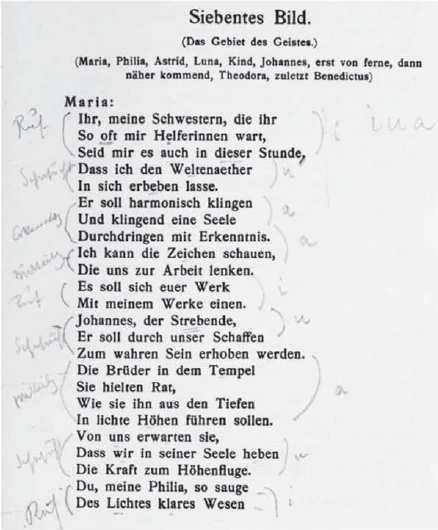
i u a / Call i/ Longing u / Knowledge a / Communication a / Call i/ Longing u / Communication a / Longing u / Call i
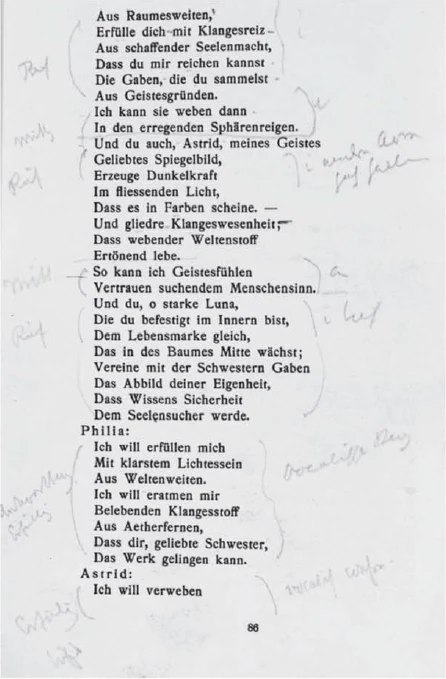
Call i / Communication u / Call i in the other arm / hold high / Communication a / Call i deep / Response movement vocal movement / Deep vocal consonant movement

Consonant fulfillment / Call a
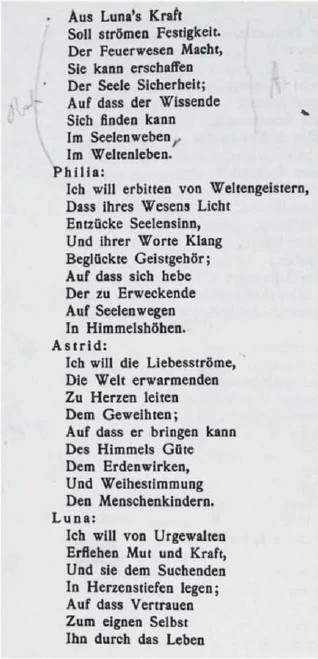
Call a
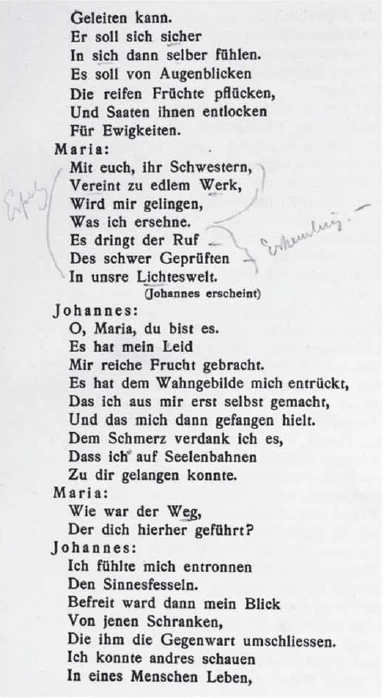
Fulfillment Knowledge
Comments by Marie Steiner, Mieta Waller, and Tatiana Kisseleff
Maria: You, my sisters, who [Express the soulfulness of the call in the first line (with i)]
So often you were my helpers,
Be so also in this hour, [MW] the call movement
That I may let the world ether [Movement of longing — from u-i]Let it tremble within itself.
[...]
And you too, Astrid, my spirit [call, holding it high in the other arm]Beloved mirror image,
Create dark power [call]
In the flowing light,
That it may shine in colors.
[...]
Become the soul seeker.
Thus a very harmoniously crafted Mary.
Philia (arm raised) tries to do the whole thing in a response movement, like a fulfillment of Mary. Vocal movement. A choir makes a consonant movement to accompany it.
Philia: I want to fulfill myself
[...]
The work can succeed.
Astrid - Fulfillment movement continuing downward. Interwoven vocally and consonantly, but not everything. The choir does what she does not do.
Luna - Fulfillment at the very bottom. Consonant. The choir vocal.Astrid: I want to interweave
[...]
Guide the rays of the soul.
Luna: I want to warm the substance of the soul
[...]
Of knowledge, create security.
Maria — everything Call: a. Three distinctions. Philia, Astrid, Luna as before
Maria:
From Philia's realms [TK: a above]
May joy flow;
And the changing powers of the mermaids, [Gradually she goes deeper and deeper down.]
[...]
From Astrid's weaving [TK: a little deeper down]
[...]
From Luna's power [TK: all the way down]
In the weaving of souls,
In the life of the world.Philia:
I want to ask the spirits of the world,
[...]Astrid:
I want the streams of love,
[...]Luna:
I want from the elemental forces
[...]Maria:
With you, sisters, [fulfill yourselves, go to the three]United in noble work,
I will succeed
In what I long for.
The call penetrates [treat everything as knowledge]
Of the severely tested
Into our world of light.
Mercury prelude
This representation can be preceded by a prelude, here especially the Mercury prelude [Mercury seal] is suitable (somewhat simplified in dance). // This includes Mercury as a prelude.
Mercury is particularly suitable where messengers appear. // Mercury prelude for such representations that contain a message or description of the spiritual world.
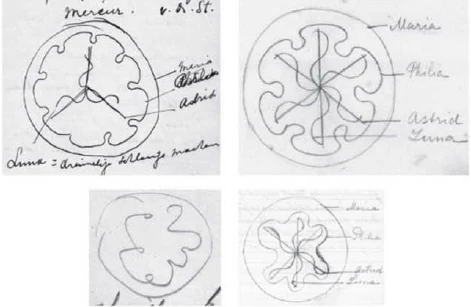
Mercury / Luna = threefold snake movement / Maria, Philia, Astrid
One makes the outer circle — walks around and hints at the Marian motif. The three vowels and the call and recognition movement.
Maria makes movements, accompanied only by music.
At the same time, they walk
Philia — the outer arcs around and makes her movement
Astrid — the rays back and forth
Luna — around Astrid, the twists back and forth (threefold serpent)
[Like] a main motif and three secondary motifs in music.
Philia blue. Astrid green. Luna red. Maria white.

General information on the representation of the main character and choir
Suitable for this type of portrayal are translations, scenes from Aeschylus' dramas, those in which the choruses are not dissolved. Sophocles' dramas, Schiller's Bride of Messina, etc. are scenes in which there is one main role and several secondary roles (Schiller makes extensive use of psychological observation). The middle person or persons act like Maria.
Some of Goethe's poems, which can be adapted for festive purposes, are also scenes with one main role and several supporting roles. In Goethe's “God and the World,” it is particularly important to use the concrete and the abstract, as in the scene described from “The Gate of Initiation.”
In Greek dramas (Aeschylus), there is always a main character and a chorus. Main character: vowels ;, a, #. No consonants. All conjunctions, prepositions, all states of mind (pain and joy, concrete and abstract) can be performed by the main character. Any sacrificial acts that occur are also performed by the main characters.
The servant interprets. // The chorus expresses what fills the middle person. // The chorus does what the main character does not do. // The chorus makes letters, vowels and consonants, the concrete and the abstract, the states of mind.
That is the secret of the Greek chorus, that it expresses what moves the middle character, // what fills the middle character.
The large chorus is usually divided into two groups, // the chorus can be divided into chorus and counter-chorus. The choruses then stand slightly recessed, the characters elevated.
The Greeks had these movements. As a spoken drama, it was not beautiful; it was a blaring and trumpeting. Only through emotional involvement was it appropriate to the content.
Performance of the “Devachan Scene” April 1915
In the Easter program of April 4, 1915, in addition to the first scene from Faust 1 (Study Room) and other singing and eurythmy performances, the seventh scene from “The Fortress of Initiation” was also performed. Marie Steiner recited, and Tatiana Kisselejf portrayed all three soul forces, each ‘changing the veil for each soul force. In reference to this, Tatiana Kisselef noted in the galley proofs: 'T. K. received these forms for her personal work in the summer of 1914.’
Another type of representation for the same scene (performed on April 4, 1915).
Maria recites or vocalizes while standing. The three soul forces in this position.
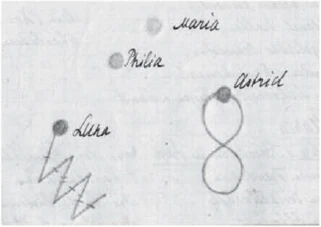
Philia vocal - standing
Astrid consonantal – in motion
Luna vowels and consonants in motion. (-v-|--|-v-|--)
Luna: vowels and consonants in amphimacer, performing spondee rhythms on the specified form -v-|--| v-|-- etc., back and forth. Maria: yellow. Philia: white dress, light green veil; Astrid: white dress, purple veil; Luna: white dress, violet veil.
Further notes relating to this scene
The extent to which the following notes by Rudolf Steiner and Marie Steiner are directly related to the seventh picture from the “Forty Days of Initiation” is uncertain. However, as they belong in the broader context, they are documented here.
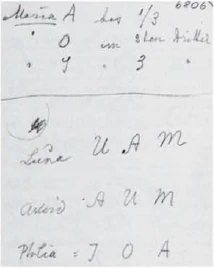
Maria a to 1/3 / Maria o in the 2nd third / Maria i in the 3rd third // A Luna u a m / Astrid a u m / Philia: i o a
Program for the performance on August 30, 1915, 7 p.m., Dornach
Exact repetition of the program from August 29, 1915 [see p. 348]
[The following remarks on the performance of the Mercury prelude before the depiction of the Devachan scene were found in the preliminary galley proofs but were not included in the final edition.]
Mercury prelude. Music by Leopold van der Pals. [...] At the beginning of the music, Philia, then Astrid, then Luna, and finally Maria appear one after the other. They all begin their paths at the same time. Maria moves on the outer circle, hinting at the Marian motif in the music and forming the vowels i, u, a, u like au, touching each other, in movements of calling and recognition. Philia runs the round shapes, accompanying Maria's path in the i- above in the emotional zone. Astrid runs the rays back and forth in a - in front of her in the thinking zone, and Luna also runs the turns around Astrid's ray shape back and forth. In the music, a main motif and three secondary motifs can be recognized. During the grand crescendo, the choirs enter from three sides and group themselves around Maria, Philia, Astrid, and Luna in a semicircle, who continue to move in their forms. At the end of the music, everyone moves into the following formation.
[Tatiana Kisseleff on the nature of the performance of the Devachan scene in 1923]
At the beginning of the music, Philia (i above), then Astrid (a in front), then Luna (u below), then Maria (in e-gesture - arms crossed at the chest - forms i, a, u in motion) appear. At the grand crescendo of the music, the choirs (each consisting of 4, 5, or 6 people) appear from three sides and group themselves in a semicircle around the four main figures, who continue to move in their paths until the end of the music.
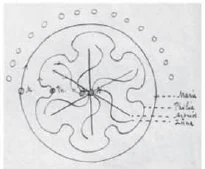
To take up the position for the text section, the transitions from the final position after the Mercury upbeat are made according to the dotted lines shown opposite into the grouping also shown opposite. The stage can also be arranged in four levels. Mary at the top, the three soul forces gradually descending. However, it was never performed according to these instructions.

[Mary “My sisters [...] What I long for”] Then the regrouping takes place silently as shown above with dotted lines, with the choir standing in a semicircle at the back = front arm lower, rear arm higher in relation to each other (like a protective chain) to the final position.
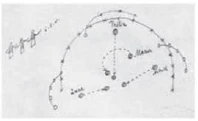
in which the main figures make the following gestures: Maria = left arm stretched over Philia's head, right arm in a middle position slightly forward towards Philia, as if protecting her; Luna in "stretched towards Philia; Astrid in a towards Philia; Philia = right arm in i above. - Final positions:

Before and after: symphonic music transitioning into choral singing, then into speech (on stage also silent eurythmy)
Dreizehnte Stunde
Das Thema dieser Stunde war die Darstellung auf Stufen für Hauptperson und «untergeordnete Person(en)» bzw. Chor oder Chöre. Als Beispiel für eine solche Darstellung wählte Rudolf Steiner den Beginn der siebten Szene aus seinem ersten Mysteriendrama «Die Pforte der Einweihung», auch «Devachan-Szene» genannt— mit Maria und den drei Seelenkraften Philia, Astrid, Luna. Die Szene wurde als Beispiel angelegt, aber damals nicht aufgeführt. Die allgemeinen Ausführungen Rudolf Steiners zu dieser Art der Darstellung werden aus Gründen der Übersichtlichkeit hier an den Anfang gestellt, obwohl sie teilweise aus der Stunde vom nächsten Tag (31. August 1915) stammen. Dort wurde das Thema unter einem neuen Aspekt - nämlich die Darstellung auf Stufen in Hinsicht auf über- und untergeordnete Gedanken - fortgeführt und erweitert; auch wurden Hinweise gegeben, welche Texte in dieser Art dargestellt werden könnten. Ursprünglich wurde also erst ein konkretes Beispiel gegeben - die siebte Szene aus dem ersten Mysteriendrama -, bevor Rudolf Steiner auf das Allgemeine zu sprechen kam.
Im Anschluss der Ausführungen zur «Devachan-Szene» wird eine etwas frühere Ausarbeitung von Tatiana Kisseleff dokumentiert. Bei der späteren Ausarbeitung 1923 wurde der Merkur-Auftakt zu Musik von Leopold var der Pals ausgeführt.
Darstellung auf drei Stufen - am Beispiel des siebten Bildes aus der «Pforte der Einweihung»
Das Tanzen von Gedichten und Dramen kann nun auf verschiedene Arten geschehen. Häufig treten eine Hauptperson und drei untergeordnete Personen, eine Hauptperson und drei Chorführerinnen auf. Stets kann ein [Chor] oder mehrere Chöre hinzugefügt werden. Z.B. Szenen wie [das siebte Bild der] «Pforte der Einweihung» kann man auf folgende Art darstellen:
Als Hauptperson tritt Maria auf, daneben Philia, Astrid und Luna. Drei Stufen:

Zu dieser Szene gehört als Auftakt der Merkur [das Merkur-Siegel] (etwas zu vereinfachen im Tanze).
Maria oben, die drei Seelenkräfte stufenweise angeordnet (Philia — obere Stufe, Astrid — mittlere Stufe, Luna — niedere Stufe)
Maria
Eurythmisch harmonisch ausgearbeitete Maria, die ihre Worte oben im ersten Kreis selber spricht.
Maria macht das Konkrete und Abstrakte und Zeitwörter (vor und zurück) und die Vokale i, u (wie as) und a. Sie bringt seelisch zum Ausdruck: Ruf, Sehnsucht, Mitteilung, Erkenntnis
in — Ruf, u Sehnsucht, a Mitteilung oder Erkenntnis.
Aber nicht mehr Vokale wie angegeben, drei Bewegungen. Das u kann auch als Berührung von Maria gemacht werden, wie in aum.
Als ich mit Frau Doktor versuchte, die Maria auszuarbeiten, haben wir ganz wenig Formen gemacht, z.B. die ersten zwei Zeilen einen konkreten Winkel, die dritte eine abstrakte Form. [...] Ich erinnere nur, dass [Rudolf Stein]er zu den Gesten i a u für die Hauptperson sagte: «Es ist möglich, sogar Handlungen innerhalb dieser Laute auszuführen, z.B. Opferhandlungen der Elektra.» Grade diese Szene wollte Frau Doktor mit mir versuchen. Aber leider fehlte die Zeit damals.
Dr. auf Tafel: i — Ruf; u — Sehnsucht; a — Mitteilung oder Erkenntnis.
Philia
Versucht das Ganze in eine Antwort zu bringen, in eine Antwortbewegung zu tun. Erfüllung nach der Maria zu. Vokalische Bewegungen, möglichst hoch halten, und noch extra ein Chor, der die Konsonanten dazu macht. // Antwort - Erfüllung, nach Maria (hinten) zu, sie [Philia] bildet alle Vokale, der Chor ergänzt die Konsonanten (nach oben) // Eine Art Antwort, die drei sind der Chor, die Erfüllung geht nach der Maria hin. Philia vokalische Bewegungen
Astrid
Wiederum Erfüllungsbewegungen, aber etwas weiter herunter mit [den] Armen wie Philia. Astrid vokalisch-konsonantisch, dem Chor wird das [übJerlassen, was sie nicht tut. // Antwort - Erfüllung. Bewegung nach Maria zu, in der Mitte, sie [Astrid] bildet die Vokale und kann sich die Konsonanten wählen, der Chor bildet die Restkonsonanten. // Erfüllungsbewegungen, durcheinanderweben, vokalisch mit konsonantisch. Mit dem Chor besprechen, welche Konsonanten sie ihm überlässt.
Luna
Erfüllung ganz unten, konsonantisch. Dem Chor das Vokalische überlassen. // Ganz konsonantisch. Überlässt Chor Vokale. // Antwort — Erfüllung. Bewegung nach Maria zu, nach unten, sie bildet die Konsonanten, der Chor ergänzt die Vokale.
Die Bewegungen der drei Seelenglieder nur in zwei Dimensionen. Sich den Körper in drei Ebenen geteilt denken.
So stehen die Gestalten im Spirituell-Realen vor einem. // So schafft man aus dem Spirituellen-Realen heraus.
Maria drückt die Erfüllung aus gegen die drei zu.
Maria an Philia folgt: «a-Bewegung + Ruf (hoch)
Maria an Astrid: a-Bewegung, Ruf mehr nach unten, etwas tiefer herunter
Maria an Luna: a-Bewegung noch mehr nach unten, ganz nach unten.
Maria macht in dem, was dann folgt, die Erfüllungsbewegung zu den dreien. «Es dringt der Ruf des Schwergeprüften», als Erkenntnis zu behandeln.
Philia: Kopfhaltung: Gefühl
Astrid: Kopfhaltung: Denken. Alle Bewegungen in der mittleren Ebene.
Luna: Kopfhaltung: Wille
Philia: Sie bewegt sich in apollinischen Formen. Den Kopf zurück nach oben. Astrid: Kopf gesenkt. Formen Luna: Formen. Kopf geradeaus
Ich persönlich versuche immer deutlich zu machen, dass Philia, Astrid, Luna nicht 1dentisch sind.mit den.ursprünglich gegebenen Kopfbaltungen für Denken, Fühlen und Wollen. Von Zonen hat Dr. Steiner nie im Zusammenhang mit Denken, Fühlen und Wollen gesprochen, sondern eben für die objektiven geistigen Wesenheiten, welche die Verbindung der menschlichen Seelenkräfte mit dem Kosmos vermitteln. Wie ich schon bei den Formen für Denken, Fühlen und Wollen ausdrücklich betont habe, hat Dr. Steiner niemals diese drei menschlichen Seelenkräfte mit Philia, Astrid und Luna in Zusammenhang gebracht, weder in Bottmingen noch im letzten Lauteurythmiekurs. Wie wollen Sie denn z.B. Schmerz oder Spannung oder Sehnsucht in der Philia-Zone ausdrücken?
Anmerkungen Rudolf Steiners in «Die Pforte der Einweihung» (RSB St 40)

i u a / Ruf i/ Sehnsucht u / Erkenntnis a / Mitteilung a / Ruf i/ Sehnsucht u / Mitteilung a / Sehnsucht u / Ruf i

Ruf i / Mitteilung u / Ruf i im andern Arm / hoch halten / Mitteilung a / Ruf i tief / Antwortbewegung Erfüllung vocalische Bewegung / Erfüllung tiefer vocalisch consonantisch

Erfüllung consonantisch / Ruf a

Ruf a

Erfüllung Erkenntnis
Anmerkungen von Marie Steiner, Mieta Waller und Tatiana Kisseleff
Maria: Ihr, meine Schwestern, die ihr [Zum Ausdruck bringen das Seelische des Rufs in der ersten Zeile (mit i)]
So oft mir Helferinnen wart,
Seid mir es auch in dieser Stunde, [MW] die Rufbewegung
Dass ich den Weltenäther [Sehnsuchtsbewegung — von u-i]In sich erbeben lasse.
[...]
Und du auch, Astrid, meines Geistes [Ruf, im andern Arm hochhaltend]Geliebtes Spiegelbild,
Erzeuge Dunkelkraft [Ruf]
Im fließenden Licht,
Dass es in Farben scheine.
[...]
Dem Seelensucher werde.
Damit eine sehr harmonisch ausgearbeitete Maria.
Philia (hoch Arm) versucht das Ganze in eine Antwortbewegung zu tun, wie eine Erfüllung der Maria zu. Vokalische Bewegung. Ein Chor dazu macht konsonantische Bewegung.
Philia: Ich will erfüllen mich
[...]
Das Werk gelingen kann.
Astrid - Erfüllungsbewegung weiter heruntergehend. Durcheinan derweben vokalisch und konsonantisch, aber nicht alles. Der Chor macht, was sie nicht macht.
Luna - Erfüllung ganz unten. Konsonantisch. Der Chor vokalisch.Astrid: Ich will verweben
[...]
Die Seelenstrahlen lenken kannst.
Luna: Ich will erwärmen Seelenstoff
[...]
Des Wissens Sicherheit erzeugen kannst.
Maria — alles Ruf: a. Drei Unterscheidungen. Philia, Astrid, Luna wie vorher
Maria:
Aus Philias Bereichen [TK: a oben]
Soll strömen Freudesinn;
Und Nixen-Wechselkräfte, [Allmählich geht sie immer tiefer hinunter, herunter.]
[...]
Aus Astrids Weben [TK:a etwas tiefer herunter]
[...]
Aus Lunas Kraft [TK: a ganz nach unten]
Im Seelenweben,
Im Weltenleben.Philia:
Ich will erbitten von Weltengeistern,
[...]Astrid:
Ich will die Liebesströme,
[...]Luna:
Ich will von Urgewalten
[...]Maria:
Mit euch, ihr Schwestern, [macht selbst Erfüllung, geht zu den Dreien zu]Vereint zu edlem Werk,
Wird mir gelingen,
Was ich ersehne.
Es dringt der Ruf [alles als Erkenntnis behandeln]
Des schwer Geprüften
In unsre Lichteswelt.
Merkurauftakt
Dieser Darstellung kann vorangehen ein Auftakt, hier besonders der Merkurauftakt [Merkursiegel] geeignet (etwas zu vereinfachen im Tanze). // Zu dem gehört als Auftakt der Merkur.
Merkur besonders geeignet, wo Boten auftreten. // Merkurauftakt für solche Darstellungen, die eine Botschaft oder Schilderung der geistigen Welt zum Inhalt haben.

Mercur / Luna = dreimalige Schlange machen / Maria, Philia, Astrid
Eine macht den äußeren Kreis — geht herum und deutet das Marienmotiv an. Die drei Vokale und Ruf und Erkenntnis-Bewegung.
Maria macht Bewegung, stumm nur von Musik begleitet.
Zu gleicher Zeit gehen
Philia — die äußeren Bogen herum und macht ihre Bewegung
Astrid — die Strahlen hin und zurück
Luna — um Astrid herum die Windungen vor und zurück (dreimalige Schlange)
[Wie] ein Hauptmotiv und drei Nebenmotive in Musik.
Philia blau. Astrid grün. Luna rot. Maria weiß.

Allgemeines zur Darstellung von Hauptperson und Chor
Geeignet für solche Art der Darstellung sind Übersetzungen, Szenen von Äschylos-Dramen, solche, in denen die Chöre nicht aufgelöst sind. Sophokles-Dramen, Schillers Braut von Messina etc. sind solche Szenen, wo eine Haupt- und mehrere Nebenrollen sind (bei Schiller sehr viel seelische Beobachtung verwendet). Die Mittelperson oder -personen machen es wie Maria.
Auch einige Goethe’sche Gedichte, die für festlichen Zweck in der Weise gemacht werden können, sind solche Szenen, wo eine Hauptund mehrere Nebenrollen sind. Bei Goethe («Gott und Welt») besonders das Konkrete und Abstrakte zu verwenden, wie in der geschilderten Szene aus der «Pforte der Einweihung».
In griechischen Dramen (Äschylos) immer eine Hauptperson und ein Chor. Hauptperson: Vokale ;, a, #. Keine Konsonanten. Alle Konjunktionen, Präpositionen, alle Seelenzustände (Schmerz und Freude, Konkret und Abstrakte) kann die Hauptperson machen. Auch vorkommende Opferhandlungen werden durch die Hauptpersonen ausgeführt.
Die Dienerin interpretiert. // Der Chor drückt aus, was den Mittleren erfüllt. // Der Chor tut das, was die Hauptperson nicht tut. // Chor macht Buchstaben, Vokale und Konsonanten, das Konkrete und das Abstrakte, die Seelenzustände.
Das ist das Geheimnis des griechischen Chors, dass er das ausdrückt, was den Mittleren bewegt, // was den Mittleren erfüllt.
Der große Chor steht gewöhnlich in zwei Gruppen verteilt, // Chor kann in Chor und Gegenchor eingeteilt werden. Die Chöre stehen dann etwas vertieft, die Personen erhöht.
Bei den Griechen waren diese Bewegungen. Als Sprechdrama war es nicht schön, es war ein Schmettern und Trompeten. Nur durch das seelische Mitgehen - inhaltsgemäß war es.
Ausführung der «Devachan-Szene» April 1915
Im Osterfestprogramm vom 4. April 1915 wurde neben der ersten Szene aus Faust 1 (Studierzimmer) sowie anderen Gesangs- und Eurythmie-Darbietun‚gen auch das siebte Bild aus der «Fforte der Einweihung» aufgeführt. Marie Steiner rezitierte, und Tatiana Kisselejf stellte alle drei Seelenkräfte dar, jeweils ‚für jede Seelenkraft den Schleier wechselnd. In Bezug darauf vermerkte Tatiana Kisselef in den Druckfahnen: «T. K. bekam diese Formen für ihre persönliche Arbeit im Sommer 1914.»
Eine andere Art von Darstellung für dieselbe Szene (so aufgeführt am 4. April TR. 1915).
Maria rezitiert oder vokalisiert stehend. Die drei Seelenkräfte in dieser Stellung.

Philia vokalisch - stehend
Astrid konsonantisch - in Bewegung
Luna Vokale und Konsonanten in Bewegung. (-v-|--|-v-|--)
Luna: Vokale und Konsonanten in Amphimacer, Spondeus-Rhythmen auf die angegebene Form ausführend -v-|--| v-|-- usw., hin und zurück. Maria: gelb. Philia: weißes Kleid, hellgrüner Schleier; Astrid: weißes Kleid, purpurner Schleier; Luna: weißes Kleid, violetter Schleier.
Weitere Notizen im Umkreis dieser Szene
Inwieweit die folgenden Notizen Rudolf Steiners und Marie Steiners im direkten Zusammenhang mit dem siebten Bild aus der «F’forte der Einweihung» in Zusammenhang stehen, ist ungewiss. Da sie aber in den weiteren Kontext gehören, werden sie hier dokumentiert.

Maria a bis 1/3 / Maria o im 2ten Drittel / Maria i im 3ten Drittel // A Luna u a m / Astrid a u m / Philia: i o a
Programm zur Aufführung vom 30. August 1915, 19 Uhr, Dornach
Genaue Wiederholung des Programms vom 29. August 1915 [siehe S. 348]
[Die folgenden Ausführungen über die Ausführung des Merkurauftaktes vor der Darstellung der Devachan-Szene fanden sich in den vorläufigen Druckfahnen, wurden aber nicht in die Ausgabe aufgenommen.]
Merkurauftakt. Musik von Leopold van der Pals. [...] Zu Beginn der Musik treten nacheinander Philia, dann Astrid, dann Luna und zuletzt Maria auf. Alle beginnen ihre Wege zu gleicher Zeit. Maria bewegt sich auf dem äußeren Kreis, das Marienmotiv in der Musik andeutend und die Vokale i u a, u wie au, sich berührend, in Ruf und Erkenntnisbewegungen bildend. Philia läuft die runden Formen, die Bahn der Maria begleitend im i- oben in der Gefühlszone. Astrid läuft die Strahlen hin und zurück in a - vor sich in der Denkzone, und Luna führt die Windungen um die Strahlenform der Astrid auch hin und zurück aus. In der Musik sind ein Hauptmotiv und drei Nebenmotive zu erkennen. Bei dem großen Crescendo treten von drei Seiten die Chöre ein und gruppieren sich um Maria, Philia, Astrid und Luna in einem Halbkreis, welche sich weiter in ihren Formen bewegen. Am Ende der Musik gehen alle in folgende Aufstellung.
[Tatiana Kisseleff über die Art der Ausführung der Devachan-Szene 1923]
Beim Anfang der Musik treten Philia (i oben), dann Astrid (a vor sich), dann Luna (u unten), dann Maria (in e-Gebärde - an der Brust gekreuzte Arme -, bildet in Bewegung i, a, u) auf. Beim großen Crescendo der Musik treten von drei Seiten die Chöre (jeder besteht aus 4, 5 oder 6 Personen) auf und gruppieren sich im Halbkreis um die vier Hauptgestalten, die sich in ihren Bahnen weiterbewegen bis zum Ende der Musik.

Um die Stellung für den Textteil einzunehmen, erfolgen aus der Schluss-Stellung nach dem Merkurauftakt die Übergänge gemäß neben stehenden strichlierten Linien in die ebenfalls nebenstehende Gruppierung. Die Bühne kann auch in 4 Stufen gestaltet sein. Maria oben, die drei Seelenkräfte stufenweise nach unten. Nach dieser Angabe wurde es aber nie aufgeführt.

[Maria «Ihr meine Schwestern [...] Was ich ersehne»] Dann erfolgt stumm die Umgruppierung wie oben mit strichlierten Linien gezeigt, wobei sich der Chor hinten im Halbkreis aufstellt = vorderer Arm mehr unten, hinterer Arm höher zueinander (wie eine schützende Kette) zur Endstellung,

bei der die Hauptgestalten folgende Gebärden machen: Maria = linker Arm gestreckt über den Kopf von Philia, rechter Arm mittlere Lage etwas nach vorne gegen Philia, wie schützend; Luna in « zu Philia gestreckt; Astrid in a gegen Philia; Philia = rechter Arm in i oben. - Endstellungen:

Vorher und nachher: symphon. Mus. übergehend in Chorgesang, dann in Sprechen (auf der Bühne auch stumme Eurythmie)

